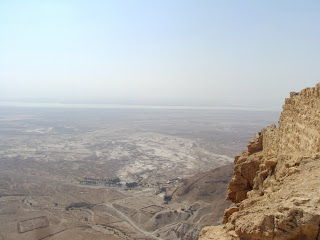We were up early and on the bus at 8am for the trek to the Dead Sea area. Our first stop was at Masada, a fortress built by Herod the Great as a place of protection for his family. On his way to Rome, Herod left his family there. After he defeated his enemies and was declared king with Roman support, he returned to Masada with Roman soldiers to retrieve his family. They were still living, in spite of the lack of supplies, so Herod saw this as a good place of protection and built one of his seven fortresses here between 37 and 31 BC.
In the first Jewish War against the Roman Empire, Jewish extremists called the Sicarii overtook the fortress at Masada, and after the destruction of the Temple, many Jewish rebels fled to Masada. Josephus recorded a famous account of the siege against Masada by the Romans, where the Romans surrounded Masada below with multiple camps and built a rampart up to the wall of the fortress. They finished the rampart in 73, but when they breached the wall, they discovered that the Jewish community there had set the store rooms ablaze and committed mass suicide, rather than be taken prisoner or killed by Roman hands. This story was told to Josephus by two women who hid with their children in a cistern and escaped after the siege. Every man killed his own family, then the men made a lottery, selecting 10 to kill all the men, and then 1 to kill the remaining 9 and then himself.
I hope these photos give some idea of the harshness of this landscape. Not only is it steep and rocky, but the temperatures here are oppressive - 42 degrees today, and I don't mean Fahrenheit! 





The snake path - the winding path for walking up the mountain to Masada at the top:
There is nothing like being in the desert to remind you how important water is. Nassir, our guide says that when Jerusalem receives flash floods, the water rushes down through the Judean Desert to the Dead Sea. You can see the effects of these flash floods, with all the gorges cut out in the land by rushing water. I bet these floods are a sight to behold, and of course very dangerous. But the inhabitants of Masada took advantage of these floods by carving small aqueducts in the mountain rock leading to cisterns to collect this rushing water for later use.
Our next stop was Qumran, the site of approximately 300 caves where the Dead Sea Scrolls were discovered. The combination of the dry weather and the jars in which they were stored is what helped preserve these fragile documents. These scrolls contained books of the Bible as well as texts describing their traditions on how the Essenes lived together.

After lunch in Jericho, we made the short drive to a swimming area along the Dead Sea. It's best only to swim in designated areas because sink holes are prevalent and very dangerous. We even experienced a small taste of them in the swimming area, sometimes sinking into the mud up to our knees!
Me - floating in the Dead Sea. Did you know that the Dead Sea is 35% salt, as compared with other oceans/seas that average only 3%??? Now that's salty!! The Dead Sea is also below "sea level" and is the lowest place on earth...
Here's Justin doing a little light reading...














No comments:
Post a Comment